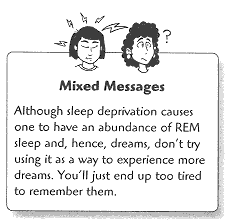|
|
|
|
|
|
|
What's Happening When You're Asleep? |
|
|
|
|
|
|
|
|
By monitoring sleep patterns, researchers have identified when most dreams take place. Most people follow the same sleep patterns every night, falling asleep and going deeper and deeper into a relaxed state for about the first 90 minutes. At that point, they enter a phase called REM sleep, which is marked by rapidly moving eyelids and dreaming. When researchers wake up their subjects during REM sleep, the subjects almost always report that they've been dreaming, and these dreams are often quite vivid. |
|
|
|
|
|
|
|
|
Most people undergo REM sleep three of four times a night, following a 90-minute cycle. However, within each cycle, REM sleep lasts progressively longer: While the first period of REM-period sleep may last only 15 minutes or so, your final REM stage may last as long as 45 minutes. And since dreams correspond to REM stages, the average dream usually lasts between 15 and 45 minutes15 minutes early in the night, and 45 right before you wake up. |
|
|
|
|
|
|
|
|
 |
|
|
|
|
|
|
|
|
But the time leading up to REM sleep and occurring between the cycles isn't wasted either. Although the other stages of sleep primarily serve to rest the body and mind, you may also have dream-like activity at this time, although it tends to be more mundane, similar to normal thinking, and less symbolic in content. In fact, only about 15 percent of subjects who awaken from non-REM sleep remember what they were dreaming, while subjects who awaken during REM sleep almost always recall something about their dreams. They also report having much more bizarre, illogical, and emotionally or visually charged dreams during REM. These ''charged" dreams also may help the sleeper remember them. |
|
|
|
|
|
|
|
|
When a person is sleep deprived, he or she definitely shows a need for more REM sleep. When that person does get a chance to sleep, he or she undergoes an effect called REM rebound, when the body tries to make up for REM time that is lost. This causes the person to experience much higher rates of REM sleep, with longer REM stages and fewer intervening sleep stages. |
|
|
|
|
|
|
|
|
In addition to supplying a rich source of vivid dreams, the REM stage of sleep seems to meet other needs. In fact, the body and mind depend on getting a certain amount of REM sleep, and most scientists believe that |
|
|
|
|
|